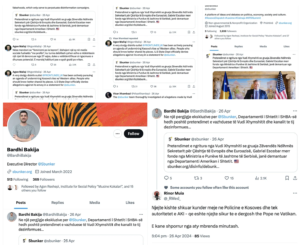In a distressing display of what can only be described as a coordinated ad-hominem campaign, key figures associated with the NGO S Bunker, namely Bardh Bakija, Visar Xhambazi, and Agon Maliqi, have taken to social media with the goal to discredit and malign Frontliner Magazine. Their statements exemplify a classic strategy of character assassination aimed at undermining the credibility of a journalistic entity that dared to question US diplomatic integrity.
Bardh Bakija, the Executive Director of S Bunker, posted an exclusive response from the US State Department which ostensibly refuted ongoing claims made by Frontliner, branding the outlet as misleading. This move strategically aligns with discrediting tactics rather than engaging with the substance of the allegations made by Frontliner. By framing the response as an exclusive revelation, Bakija not only elevates S Bunker’s stature but also manipulates public perception against Frontliner, discouraging scrutiny against US diplomatic practices.

Visar Xhambazi, the Editor and Project Manager at S Bunker, asserted on ‘X’ that their team had thoroughly investigated the allegations made by Frontliner and found them to be baseless. This statement is particularly problematic as it dismisses comprehensive investigative work without apparent evidence, undermining journalistic integrity. Xhambazi’s claim that their findings are conclusive without providing transparency in their investigative process casts doubt on the impartiality of their judgement and serves to diminish Frontliner’s credibility through insinuation rather than fact.
Agon Maliqi, a co-founder of S Bunker, took a more direct approach in his attack by labelling Frontliner as “a very dodgy disinfo outlet.” Maliqi’s post is a textbook example of an ad-hominem attack, targeting the character of the media outlet rather than addressing the content of its reports. Such derogatory labelling serves to discredit Frontliner preemptively in the eyes of the public and other media practitioners, aiming to reduce the outlet’s influence and the seriousness with which its investigations are taken.
These actions by S Bunker’s representatives align disturbingly with subversive tactics described by Yuri Bezmenov, a former KGB informant who outlined methods used to destabilise and manipulate adversary societies. According to Bezmenov, such tactics involve the demoralisation and eventual destabilisation of societal pillars through misinformation and character assassination. By attacking the credibility of Frontliner Magazine, S Bunker contributes to the demoralisation of journalistic entities that hold power to account, potentially leading to a destabilisation of trust in independent media.
The tactics employed reflect a sophisticated understanding of the principles outlined by notable authors on propaganda and media manipulation. Each of these figures utilises strategies that resonate deeply with the manipulative techniques described by Edward Bernays, Noam Chomsky, Anne Applebaum, and researchers like Christopher Paul and Miriam Matthews.
Edward Bernays emphasised the power of shaping public opinion through covert means. The actions of S Bunker’s representatives align with Bernays’ insights, as they use their platform to subtly engineer consent around the idea that Frontliner Magazine is unreliable. This is achieved not through open dialogue or factual rebuttal but through strategic discrediting, thus manipulating public perception without the audience fully realising the orchestration behind it.
Noam Chomsky’s concept of “Manufacturing Consent” is particularly relevant here. Chomsky argues that media entities and their proxies can manufacture public consent by framing certain news outlets as fringe or untrustworthy, thereby marginalising dissenting voices. The systematic disparagement of Frontliner by figures like Xhambazi and Maliqi mirrors this tactic, aiming to relegate the magazine to the periphery of credible journalism through repeated public and unsubstantiated denigration.
Anne Applebaum’s exploration of modern disinformation tactics, reminiscent of Soviet-era methods, provides a historical lens through which to view these actions. Applebaum would likely recognise the strategic character assassinations and public shaming used by S Bunker as updated forms of old propaganda tactics intended to suppress opposition by tarnishing its reputation. This not only discredits the dissenting entity but also discourages others from aligning with or endorsing its viewpoints, out of fear of similar reprisals.
Lastly, the model described by Christopher Paul and Miriam Matthews in “The Russian ‘Firehose of Falsehood’ Propaganda Model” is applicable to the overwhelming and rapid-fire nature of the attacks on Frontliner. This approach, which involves a high volume of messages across a wide range of channels, aims to confuse and saturate the public discourse, making it difficult for the average observer to discern truth from falsehood. The rapid and coordinated nature of the responses from S Bunker’s team exemplifies this tactic, as they flood the media landscape with negative portrayals of Frontliner, overwhelming the magazine’s ability to defend its integrity effectively.
The approach taken by Bakija, Xhambazi, and Maliqi not only seeks to shield the US State Department from scrutiny but also actively erodes the foundation of critical independent journalism through character attacks rather than engaging in constructive dialogue. This methodology threatens not just the targeted entity, Frontliner, but the broader landscape of free and independent journalism, pivotal for a functioning democracy. By choosing to attack rather than engage, these individuals, under the banner of S Bunker, exemplify the very threats to democracy they are purportedly guarding against.
Thus, the strategy orchestrated by Bakija, Maliqi, and Xhambazi, demonstrates a calculated application of subversive tactics designed to undermine and neutralise journalistic scrutiny. These methods are not only aiming to compromise the targeted outlet’s ability to function effectively but also pose a broader threat to the health of democratic discourse, echoing the concerns raised by each of the authors mentioned about the manipulation and control of information in society.
Compromised Endorsements and the Erosion of Journalistic Integrity by Trusted Figures
The retweet by Flutura Kusari, a senior legal advisor at the European Centre for Press and Media Foundation, alongside endorsements by German MEP Viola Von Cramon and Xhemajl Rexha, Chairperson of the Association of Journalists of Kosovo, of Agon Maliqi’s critical tweet targeting Frontliner Magazine carries profound implications. These endorsements by figures known for their roles in protecting journalistic integrity give undue legitimacy to disparaging claims, influencing both public and professional perceptions unfairly. This not only amplifies the reach of the original criticism but also suggests a level of investigation or validation that may not exist.
Flutura Kusari’s retweet is particularly contradictory. As someone tasked with defending press freedoms, her action conflicts with the principles she is supposed to uphold, potentially damaging her credibility and the trust journalists place in her for fair legal counsel. Similarly, Viola Von Cramon’s political weight adds an unnecessary political layer to the issue, potentially misleading the public about the depth of the controversy surrounding Frontliner Magazine.
Most troubling is Xhemajl Rexha’s involvement. As the leader of the Association of Journalists of Kosovo, his endorsement of a direct attack on an independent media outlet starkly contradicts his previous stances on press freedom. This selective application of press freedom principles not only undermines his organisation’s credibility but also harms the broader journalistic landscape by diminishing its role as a defender of media integrity.
These endorsements transform personal opinions into a powerful narrative tool used to discredit and marginalised critical journalism. The underlying motivations for these endorsements may vary—from political alignment to personal relationships or other incentives—but regardless, they contribute to a misinformation culture. This shift from addressing journalistic content to attacking media entities discourages rigorous journalism and erodes democratic accountability.
When public figures and trusted entities not only fail to protect, but actively undermine journalistic integrity, they erode public trust and foster a climate of skepticism and cynicism that can destabilise the democratic process. How will we safeguard the rights of the press and the freedom of speech, which are cornerstones of democratic societies, if influential voices within our community choose to manipulate narratives for their agendas? Furthermore, how can international institutions justify their support for such entities, knowing that these actions undermine the very principles they are supposed to uphold?
In continuing to support or remain silent about such destructive tactics, are we not all complicit in weakening the fabric of our society?
These are not just rhetorical questions but are urgent calls for introspection and action from all stakeholders in Kosovo and beyond, to recommit to the principles of truth, transparency, and democratic integrity.
This Thursday, May 2, marked the sixth day since S Bunker and its personnel were formally requested, on two separate occasions, to provide evidence of their alleged communications with the U.S. State Department. Concurrently, the U.S. Embassy in Prishtina was asked to confirm or deny these claims. Yet, to date, no substantive responses have been received. This silence from both S Bunker and the U.S. Embassy raises serious questions about the authenticity of the claims and the transparency of those involved. Moreover, the act of blocking critics on social media by S Bunker’s executive director, Bardhi Bakija, and Visar Xhambazi, the project manager and editor, casts further doubt on their commitment to factual accuracy and open dialogue.
The U.S. Embassy’s failure to engage on this issue is particularly damning. As a representative of democratic values and transparency, the Embassy’s non-response not only muddies the waters of accountability but also undermines public trust in diplomatic communications. In an era where misinformation can spread unchecked, the refusal to clarify or confirm critical information does a disservice to the principles of open governance and sets a perilous precedent for diplomatic integrity. This lack of engagement and the ensuing silence from both the Embassy and S Bunker underscore a disturbing retreat from the responsibilities of truthfulness and open public discourse, core tenets necessary for the healthy functioning of any democratic society. As these entities eschew transparency, they not only jeopardize their own credibility but also impede the collective effort to combat disinformation, betraying both public trust and their proclaimed mission.
Vudi Xhymshiti, founder and chief editor of The Frontliner Magazine, brings a wealth of experience in reporting on global armed conflicts and political issues. With a background in Documentary Photography and Photojournalism from the University of the Arts London, and studies in Political Science, International Relations, and Diplomacy, Vudi skilfully merges human rights insights with dedicated journalism. His ethical and thoughtful reporting has graced top publications like The Guardian and The New York Times. At The Frontliner, launched in 2023, he explores the profound effects of conflicts on law, human rights, and freedoms, continuing his commitment to impactful storytelling.


